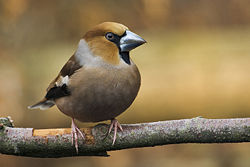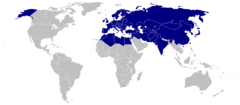Hawfinch
2008/9 Schools Wikipedia Selection. Related subjects: Birds
| Hawfinch | ||||||||||||||
|---|---|---|---|---|---|---|---|---|---|---|---|---|---|---|
 |
||||||||||||||
| Conservation status | ||||||||||||||
|
Least Concern
|
||||||||||||||
| Scientific classification | ||||||||||||||
|
||||||||||||||
| Binomial name | ||||||||||||||
| Coccothraustes coccothraustes (Linnaeus, 1758) |
||||||||||||||
 |
The Hawfinch, Coccothraustes coccothraustes, is a passerine bird in the finch family Fringillidae. As its closest living relatives are the Evening Grosbeak (C. vespertinus) and the Hooded Grosbeak (C. abeillei) from North America, the Hawfinch is sometimmes also konwn as European Grosbeak.
This bird breeds across Europe and temperate Asia. It is mainly resident in Europe, but many Asian birds migrate further south in the winter. It is a rare vagrant to the western islands of Alaska.
Deciduous or mixed woodland with large trees, especially Hornbeam, is favoured for breeding, including parkland. It builds its nest in a bush or tree, laying 2-7 eggs. The food is mainly seeds and fruit kernels, especially those of cherries, which it cracks with its powerful bill.
This large finch species does not form large flocks outside the breeding season, and is usually seen as a pair or small group.
The 16.5-18 cm long Hawfinch is a bulky bull-headed bird, which appears very short-tailed in flight. Its head is orange-brown with a black eyestripe and bib, and a massive bill, which is black in summer but paler in winter. The upper parts are dark brown and the underparts orange.
The white wing bars and tail tip are striking in flight. The sexes are similar. The call is a hard chick. The song of this unobtrusive bird is quiet and mumbled.
Images